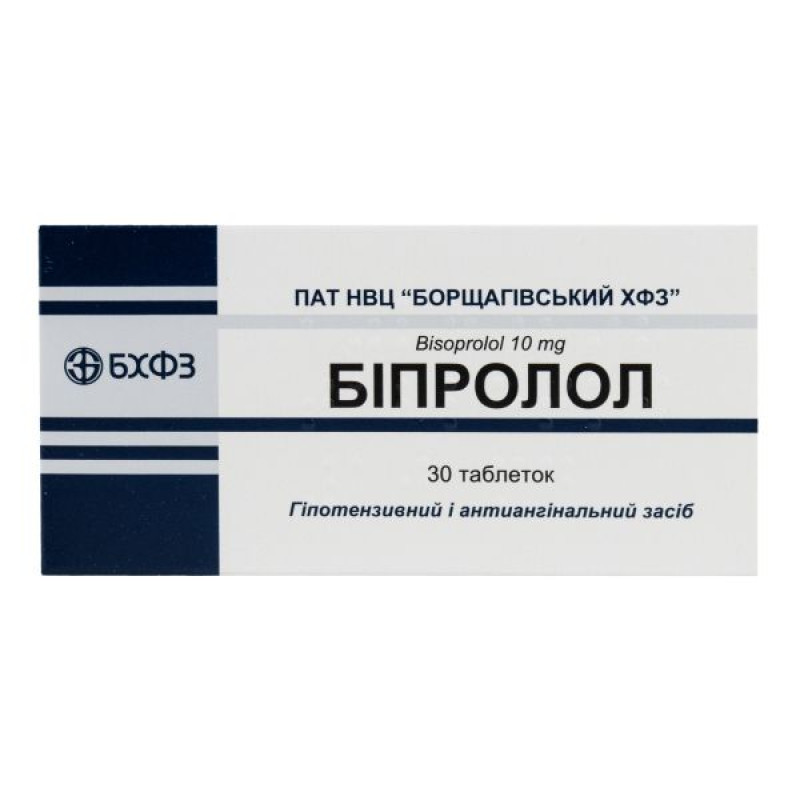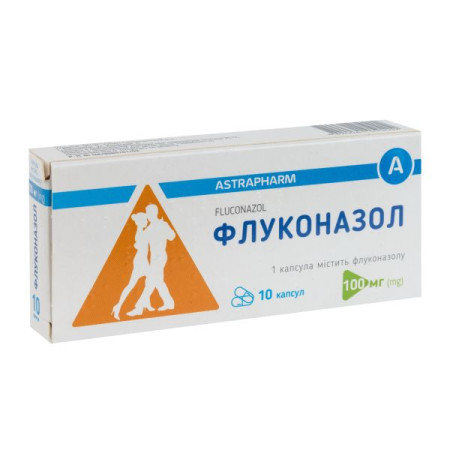Biprolol tablets 5 mg blister No. 30

Pharmacological properties
Pharmacodynamics. Bisoprolol (inn - bisoprololum) is a selective β-adrenergic receptor blocker. When used in therapeutic doses, it does not exhibit intrinsic sympathomimetic activity and clinically pronounced membrane-stabilizing properties. It has an antianginal effect: it reduces myocardial oxygen demand by reducing heart rate, reducing cardiac output and reducing PEP, increases myocardial oxygen supply by reducing end-diastolic PEP and prolonging diastole.
It has a hypotensive effect due to a decrease in cardiac output, inhibition of renin secretion by the kidneys, as well as an effect on the baroreceptors of the aortic arch and carotid sinus. With prolonged use of bisoprolol, increased peripheral vascular resistance is primarily reduced. In chronic heart failure, it suppresses the activated sympathoadrenal and renin-angiotensin-aldosterone systems. It has a very low affinity for β 2 -adrenoreceptor blockers of the smooth muscles of the bronchi and blood vessels, as well as β 2 -receptor blockers of the endocrine system. The drug can only in isolated cases affect the smooth muscles of the bronchi and peripheral arteries, as well as glucose metabolism. With a single use, its effect persists for 24 hours.
Pharmacokinetics. Absorption. After oral administration, the drug is well absorbed in the gastrointestinal tract. Bioavailability is about 90% and does not depend on food intake. C max in blood plasma is achieved 1-3 hours after a meal. Binding to plasma proteins is about 30%.
Metabolism and excretion. The effect of the first passage through the liver is insignificant (less than 10%). Approximately 50% of the dose is biotransformed in the liver with the formation of inactive metabolites. About 98% is excreted from the body by the kidneys, 50% - in unchanged form, the rest - in the form of metabolites, approximately 2% - through the intestines. T 1/2 - 10-12 hours. The pharmacokinetics of bisoprolol is linear, its indicators do not depend on age. Dose correction in patients with mild and moderate liver or kidney dysfunction is not required.
Indication
Hypertension, coronary artery disease (angina pectoris), chronic heart failure (CHF).
Application
The recommended dose is 5 mg/day (1 tablet of 5 mg).
For stage II hypertension (diastolic blood pressure up to 105 mm Hg), a dose of 2.5 mg/day (1/2 tablet of 5 mg) may be prescribed at the beginning of treatment.
If necessary, the daily dose may be increased to 10 mg (1 tablet of 10 mg).
Increasing the dose is allowed only in exceptional cases.
The maximum daily dose is 20 mg/day.
Patients with hepatic and renal impairment: Dose adjustment is usually not required in patients with mild to moderate hepatic or renal impairment.
In patients with severe renal impairment (creatinine clearance 20 ml/min) and/or severe hepatic impairment, the maximum daily dose should not exceed 10 mg of Biprolol.
In the elderly (unless they have significant renal or hepatic impairment), dosage adjustment of Biprolol is usually not required; however, this category of patients may be hypersensitive even to normal doses of the drug.
The drug is taken once a day, without chewing, regardless of meals, preferably in the morning. The course of treatment is long. The duration of therapy depends on the nature and course of the disease. It is not recommended to stop treatment abruptly. This should be done slowly, gradually reducing the dose, especially in patients with angina pectoris, since sudden cessation of treatment can lead to a sharp deterioration in the clinical picture.
Contraindication
Hypersensitivity to bisoprolol or to other components of the drug; heart failure in the decompensation phase; cardiogenic shock; AV block II and III degree (except for patients with an artificial pacemaker); sick sinus syndrome; pronounced sinoatrial block; bradycardia (heart rate 50 beats / min before the start of treatment); arterial hypotension (systolic blood pressure below 90 mm Hg); severe forms of peripheral circulatory disorders, Raynaud's disease; severe form of BA or COPD; simultaneous administration of MAO inhibitors (except for MAO-B inhibitors); combination with floctafenine and sultopride; metabolic acidosis; untreated pheochromocytoma; psoriasis (including in family history); pregnancy (except in cases where the expected benefit to the mother outweighs the potential risk to the fetus) and breastfeeding; children's age.Side effects
Adverse reactions, information on which is provided below, are classified by organ and system organ class and frequency of occurrence: very common (≥10%); common (≥1% and 10%); uncommon (≥0.1% and 1%); rare (≥0.01% and 0.1%); very rare (0.01%).
Nervous system: often: dizziness, headache, increased fatigue (especially at the beginning of treatment, symptoms are usually mild, disappear within 1-2 weeks), asthenia; infrequently: sleep disorders, depression; rarely: anxiety, nervousness, confusion (especially in the elderly), hallucinations, paresthesia, decreased speed of motor and mental reactions, nightmares, syncope.
Respiratory system: Uncommon: dyspnoea, cough, bronchospasm (especially in patients with bronchial asthma or a history of obstructive pulmonary disease); rare: nasal congestion, allergic rhinitis, sinusitis (dose-dependent effect).
Gastrointestinal tract / hepatobiliary system. Often: dyspepsia, abdominal pain, nausea, vomiting, diarrhea, constipation; rarely: cases of hepatotoxic effects of bisoprolol - increased activity of liver enzymes in blood plasma (AST, ALT), hepatitis.
Skin and subcutaneous tissue disorders: Rare: hypersensitivity reactions such as pruritus, skin rash (including urticaria, exfoliative dermatitis), angioedema, flushing, increased sweating; Very rare: alopecia, psoriatic rash, development or exacerbation of psoriasis symptoms.
Organ of vision. Rare: decreased tear secretion (should be considered when wearing contact lenses); very rare: visual impairment, eye pain/pressure, conjunctivitis.
Hearing organ. Rare: hearing impairment, tinnitus, possible ear pain.
Musculoskeletal system. Uncommon: muscle weakness, tremor/convulsions, muscle and/or joint pain, arthropathy.
Genitourinary system: Rare: impotence (decreased libido/impotence), dysuria, renal colic.
Endocrine system: Possible decrease in glucose tolerance (in latent diabetes mellitus) and masking of signs of hypoglycemia, weight gain.
Blood and lymphatic system: Agranulocytosis, thrombocytopenia, thrombocytopenic purpura are possible.
Immune system: Antinuclear antibodies may appear with the development of clinical symptoms of lupus-like syndrome, which usually disappears after discontinuation of bisoprolol treatment.
Laboratory indicators. Sometimes a slight increase in the level of TG in the blood, the concentration of uric acid, urea, creatinine, potassium in the blood serum, glucose and phosphorus, a decrease in the concentration of leukocytes, platelets. These changes, as a rule, have no clinical significance and rarely lead to the discontinuation of bisoprolol.
The appearance of side effects requires immediate correction of the prescribed dose.
Special instructions
Treatment with Biprolol is usually long-term and requires regular medical supervision. The drug cannot be canceled suddenly due to the possible development of withdrawal syndrome, manifested by an exacerbation of the disease, therefore the course of treatment should end smoothly, with a gradual reduction in dose, under the supervision of a doctor, taking into account the individual reactions of the patient.
Should be used with caution:
in patients with diabetes mellitus with significant fluctuations in blood glucose levels - symptoms of hypoglycemia (for example, tachycardia, palpitations, increased sweating) may be masked; when following a strict diet; with AV block of the 1st degree, vasospastic angina (Prinzmetal's angina), desensitizing therapy; in patients with stable CHF. Biprolol is contraindicated in exacerbation of CHF or during episodes of decompensated heart failure. Biprolol can be prescribed provided that their clinical condition is compensated and medical control is possible. Treatment is started with a minimum dose, observing careful dose titration. In case of intolerance or progression of heart failure symptoms (severe arterial hypotension, acute pulmonary edema) during dose increase, it is recommended, first of all, to reduce the dose of Biprolol or stop taking the drug; in patients with a history of COPD, asthma; Before starting treatment with the drug, it is recommended to conduct a study of the function of external respiration; during desensitization specific immunotherapy. The drug may increase sensitivity to allergens and the severity of anaphylactic reactions. Epinephrine should be prescribed with caution, as it may not have the usual effect in the treatment of anaphylaxis. An alternative to the use of high doses of adrenaline is intensive supportive measures, including the introduction of fluids and the use of β-agonists (parenteral administration of salbutamol or isoproterenol) to eliminate bronchospasm or noradrenaline - to eliminate hypotension.Biprolol is prescribed to patients with pheochromocytoma only after taking α-adrenergic blockers.
In patients with myasthenia gravis and depression (including a history of depression), the drug should be used only after careful assessment of the benefit/risk ratio. The use of bisoprolol in thyrotoxicosis may mask the adrenergic symptoms of the disease.
In patients with impaired carbohydrate tolerance, such as congenital galactosemia, glucose-galactose malabsorption syndrome, lactase deficiency, the use of the drug is contraindicated due to the fact that it contains lactose.
The drug gives a positive result in anti-doping control.
Use during pregnancy and breastfeeding. During pregnancy, the drug is used only if the expected benefit to the mother outweighs the potential risk to the fetus. As a rule, β-adrenergic blockers reduce blood flow in the placenta and may affect fetal development. It is necessary to monitor blood flow in the placenta and uterus. After delivery, the newborn should be under close medical supervision. Symptoms of hypoglycemia and bradycardia can be expected during the first 3 days. There is no data on the excretion of bisoprolol into breast milk or the safety of exposure to infants. Therefore, the drug is not recommended for use during breastfeeding.
Children: Clinical data on the efficacy and safety of the drug in children are lacking.
Ability to influence the reaction rate when driving vehicles or working with other mechanisms. Due to the individual nature of reactions when taking the drug, the reaction rate may be reduced, therefore, during treatment, driving vehicles and working with other mechanisms should be avoided.
Interactions
When using bisoprolol simultaneously with:
nifedipine and other calcium channel blockers (dihydropyridine derivatives) may enhance the hypotensive effect of bisoprolol; antiarrhythmic drugs (phenytoin, disopyramide, lidocaine, flecainide, amiodarone) - conduction disturbances and a negative inotropic effect may occur; parasympathomimetic drugs - AV conduction time may increase and the risk of bradycardia may increase; β-adrenoceptor blockers (contained in eye drops for the treatment of glaucoma) - the effect of bisoprolol may increase; insulin and oral antidiabetic drugs - a hypoglycemic effect may occur; β-adrenoceptor blockers - symptoms of hypoglycemia may be hidden; anesthetics - the risk of arrhythmia and myocardial ischemia may increase; cardiac glycosides (digitalis preparations) - may lead to a decrease in heart rate, impaired AV conduction; NSAIDs - the hypotensive effect of bisoprolol is weakened; β-sympathomimetics (dobutamine, orciprenaline) - the effect of both drugs is reduced; sympathomimetics that activate α- and β-adrenoceptors (adrenaline, noradrenaline) - blood pressure may increase and the phenomenon of intermittent claudication may increase; tricyclic antidepressants, barbiturates, phenothiazine - the hypotensive effect is enhanced; MAO inhibitors (except MAO-B inhibitors) - the hypotensive effect of β-adrenoceptor blockers is increased; Calcium channel blockers (verapamil, diltiazem), antihypertensive drugs (clonidine, methyldopa, moxinidine, reserpine) should not be used simultaneously with bisoprolol therapy - the development/intensification of bradycardia, AV block, heart failure, and decreased blood pressure are possible.Overdose
Symptoms: bradycardia, hypotension, heart failure, bronchospasm, respiratory failure, convulsions, arrhythmia (including AV block II and III degree), dizziness, hypoglycemia.
Treatment: drug withdrawal, gastric lavage, activated charcoal. If necessary, symptomatic treatment:
for bradycardia: intravenous administration of atropine; for arterial hypotension: administration of vasoconstrictor drugs, intravenous administration of glucagon; for AV blockade of the II and III degree: infusion of orciprenaline; if necessary - cardiac pacing; for worsening of heart failure: intravenous administration of diuretics; for bronchospasm: bronchodilators (for example, orciprenaline), β 2-adrenomimetics and / or euphylline; for hypoglycemia: intravenous administration of glucose.Hemodialysis is ineffective. The patient should be under close medical supervision.
Storage conditions
In the original packaging at a temperature not exceeding 25 °C.
There are no reviews for this product.
There are no reviews for this product, be the first to leave your review.
No questions about this product, be the first and ask your question.






